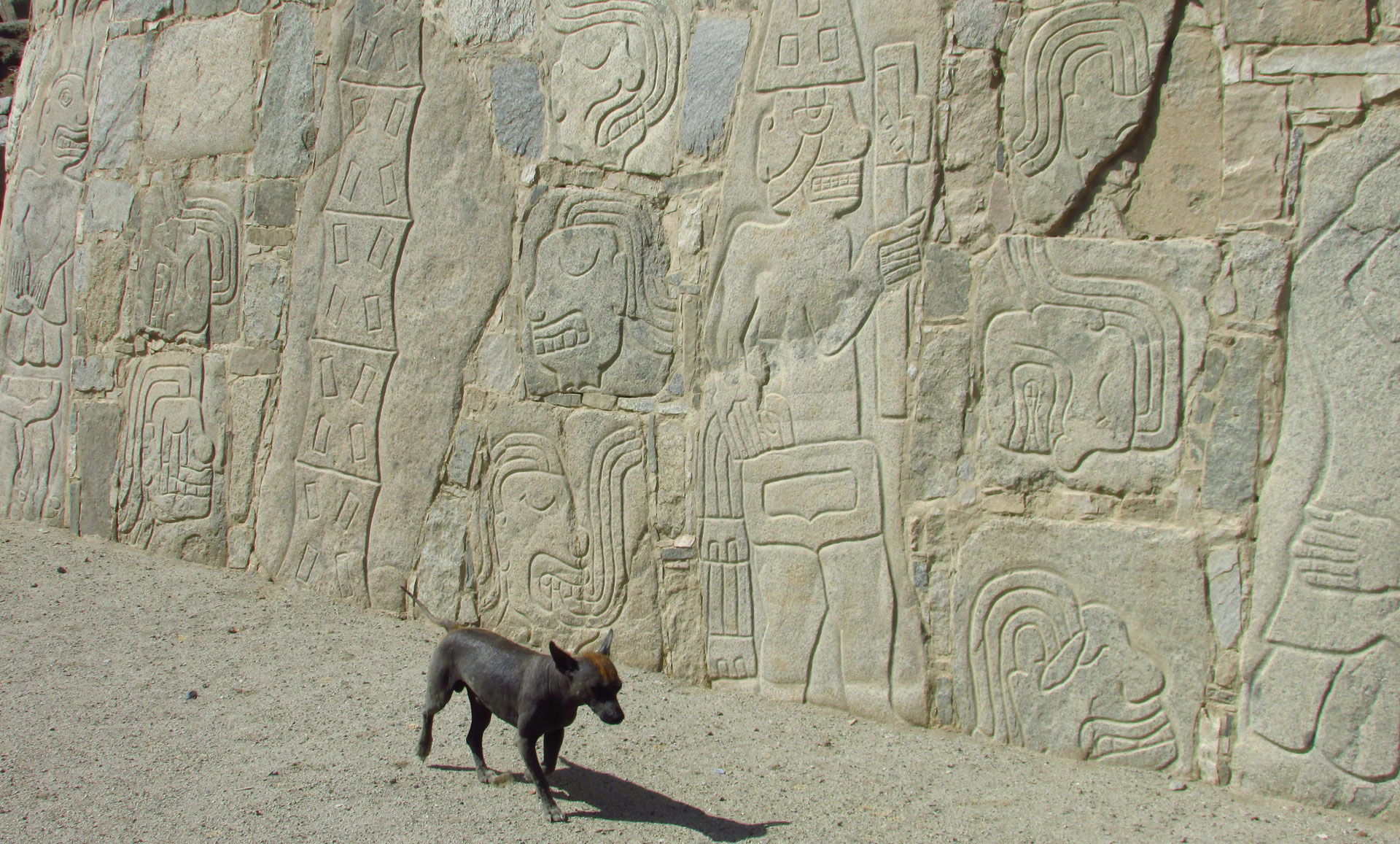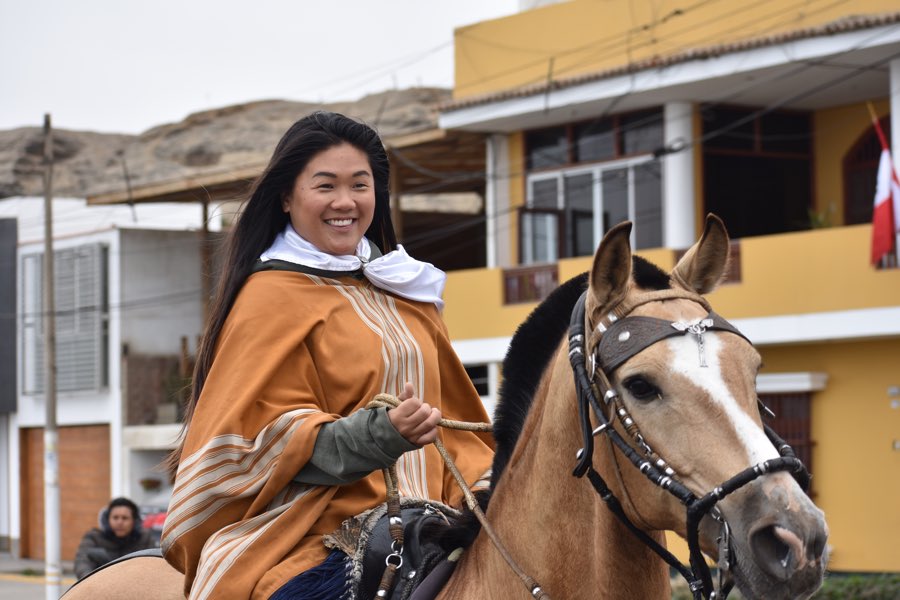Cerro Sechin is one of the most mysterious sites that can be visited on the central and northern coast of Peru. It is also one of the oldest.
Sechin is located about 300 kilometers north of the capital, Lima. We are 13 kilometers from the Pacific, on the coast of the Ancash region, 5 kilometers from the city of Casma.
In fact it is an immense archaeological complex. There are several sites in one. First Sechín Alto, one of the most extensive complexes in South America. Then, Sechin Bajo, one of the oldest in the same region. And, of course, Cerro Sechin and its warlike representations, as well as other monuments from different periods.
There is no doubt that this region on the banks of the Sechin River has many surprises for generations of archaeologists to come.
The sites of Sechin in a few figures
- Date of earliest occupation: 2,400 years before Christ, but older vestiges dating from more than 3,000 years before Christ
- Sechin area: several hundred hectares
- Number of inhabitants at its peak: it is said that the site has had up to 40,000 inhabitants
Cerro Sechin is located at the foot of a mountain that dominates the valley, 90 m above sea level.
The first archaeological excavations carried out in 1937 by the Peruvian archaeologist Julio C. Tello seemed to link the Sechin culture with the Andean civilization that is Chavin de Huantar.
But the most recent excavations approach the Sechin civilizations more to the civilisations of the coast as the Caral type. Some monuments may be older than Caral, considered today as the oldest civilization in America.
It has been shown that the Sechin culture, because of its ingenuity and its pre-eminence, influenced the Chavin de Huantar Andean culture in the same area of Ancash, which is visited near Huaraz.
You will be fascinated by the figurative style of the war stories that surround “the feline temple”.
Discovery of Sechín
It was during an archaeological survey carried out in northern Peru in 1937 that the archaeologist Julio C. Tello was led to the foot of this mountain where he could observe remains of figures engraved on the stone.
The first excavations were not easy, the stones and the monument were covered by centuries of sediments. It was still possible to discover a hundred carved stones and a monument with more than 50 meters of lateral count at its base of rounded corners.
Thanks to the research, we managed to define four periods of occupation of the site, the oldest dating back more than 4,000 years ago. But also more recent, especially by Virú or Chimú a little more than 10 centuries ago.
The place was covered by sediments on top of which the following civilisations had built their houses.
Many research and cleaning operations took place later in the 70s and 80s.
The occupation of the Sechín bajo
When it was discovered in 1937, contemporary sites were added to the Andean culture of Chavin de Huantar. There was an influence of the Chavin culture in the structures of Sechin.
The most recent excavations gave a leap in antiquity to this Sechin culture. They seem to show that, on the contrary, it would be rather the older, coastal cultures that marked their mark in this famous Andean culture of Chavin de Huantar.
In 2008, in particular on the site of Sechin Bajo, we discovered foundations and a circular buried place. They date from about 3,000 years before JC, which would project the site in earlier times to Caral.
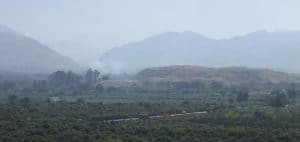
The name of Sechín comes from the name of the valley, as well as from the name of the river that crosses this valley before ending at the Sea of Grau, another name given to the Pacific Ocean.
Therefore, Sechin corresponds to the period “formativo temprano”.
It was used as a sanctuary, a sacred place.
The leader was a priest, a theocratic government (whose power seems to come directly from God).
Construction mode of the site
In the lower part, it is made of adobe bricks, conical with a circular base. There was no mortar at that time.
The whole was covered with carved stone that came from the same place.
The temple is surrounded by bas-relief stones. Over 300 stones were counted, all of them sculpted. It has a generally square shape, 50 m on each side, but with rounded corners.
The structure seems divided into 2 symmetrical parts. It was erected under the north face of the highest mountain in the area, the Cerro Laguna. A way to be closer to the gods. The majority of the population, farmers and fishermen implored the intervention of deities to obtain good harvests or peaches.
Cerro Sechin : demonstration of power
The time corresponds to the early days of agriculture, where people become aware of the notion of property. All this breeds violence and wars.
It seems that the monument of Cerro Sechin shows the victory of this civilization over the others. All this is exposed by a parade in two columns, the two columns that go to the north door where the banners, also made of stone, dominate. The symmetry seems to show a certain balance, of justice?
Monument of Cerro Sechin: a very realistic and dissuasive celebration of victories in the war
Let’s return to the Cerro Sechin site; here we celebrate the victory of the lords of Sechin over the neighbors of the coast: the warriors are represented with their weapons, axes, a helmet, and go barefoot.
There are very expressive bas-reliefs: you can see the victorious, triumphant warriors. The losers are in poor condition: heads cut off, spitting blood, holding their viscera with eyes of terror …
You will notice surprisingly long nails in these warriors, which must also have been used as weapons.
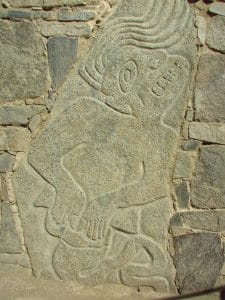
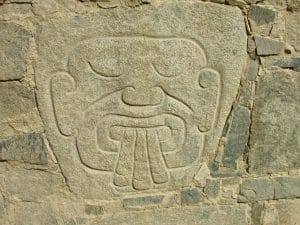
The practices of the winners towards the conquered are rather interesting : the eyes of the conquered were cut out so that he would not recognize his conqueror in his later life. Their tongues were also cut so that the dead can not accuse him.
We find in these stone representations a whole wall of eyes. The latter represented trophies of choice, a kind of expression of the soul of the vanquished.
Surely with such representations, nobody wanted to bother the Sechinos.
At that time, the ax-style weapons were made of carob wood, a protected species of today, and carved stone.
An incredible and rigorous construction
We can see in this type of “frescos” spaces where stones are missing. These are the consequences of theft and looting.
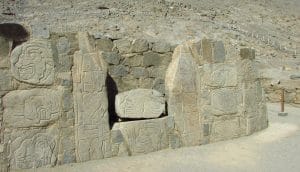
In these monuments, the East represents life, death is the West. On the front of the monument, the Western banner is dark. On the east side, near the banner, is the priest dressed well and triumphantly carrying four heads.
The sequence and the sculptures on the east side are repeated on the west side in an identical and symmetrical manner.
A thousand-year-old and continuous occupation
It has been shown that the Sechin and Casma valleys have been occupied for 8,000 years and more. They were the birthplace of cultures among the oldest in America.
Archaeologists believe that at the beginning, the site of Sechin had only 500 to 700 inhabitants, later on there were up to 40,000 people.
The site was buried, covered by layers of sediment brought by ages, winds, as well as by later cultures. Bones of more recent periods or Chimú ceramics were found, this culture still dominated the region around the 10th century AD.
.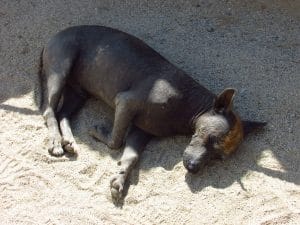
Nowadays another Peruvian heritage protects the site: I will name the Peruvian nude dog or “perro calato”.
Other archaeological sites near Cerro Sechin or Casma
In addition to Cerro Sechin, the region is full of archaeological sites, all of which are older and more important than the others.
Sechín Alto
Site near Cerro Sechin, its main monument is a pyramidal structure of 300 m in length and a height of almost 40 m. Around and in front there are Plazas, some round and buried. Sechin Alto covers an immense area of approximately 3 to 400 hectares in an area of 2 kilometers long. It is considered the largest architectural complex in Peru. It was built about 300 years after Sechin Bajo to accommodate a growing population. Therefore, it is approximately 4,000 years old.
Sechín Bajo
In front of Cerro Sechin. Construction prior to Sechin Alto at the origin of the installation of this civilization in the region. In 2008, archaelogists discoverd a circular place of stone and clay, dating back to 3,500 BC. They believe it is the oldest structure found in Peru.
Chanquillo
About 15 kilometers from Casma, it is a stone fortress and watchtower. With 13 towers aligned from north to south, dating back more than 2000 years, it is the oldest solar observatory in America. The Incas themselves would have used it during their most recent domination of the region.
Las Haldas
Another architectural group formed by stone buildings, platforms with sea views.
Moxeque or Mojeque and les Pampas de las Llamas
Another architectural ensemble, an ancient village whose occupation would have been between 1800 and 900 BC. There are terraces, a large pyramid 160 m wide with rounded base angles and 30 m high murals.
El purgatorio
The largest architectural complex in the region. It is considered the capital of the Casma culture.
An important region for archaeology
Archaeology in the Casma region is something very important. For history fans who want to see beyond the short history of the Incas in Peru, this region contains innumerable treasures. And we are certainly only at the beginning of its discovery.
How to get to Sechín ?
The site of Sechin is located about 5 kilometers from the coastal city of Casma, in the Ancash region. We are just over 300 kilometers north of Lima.
Get to Sechin from Huaraz and the Cordillera Blanca
We arrive to Casma from Huaraz by bus from the Alas Peruanas bus company. The buses are sometimes a little folk, you can miss one or two screws. Don’t say I didn’t tell you.
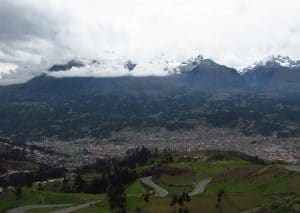
The route passes through incredible mountain landscapes, including the Punta Callán Pass at 4,224 m altitude. The Huaraz-Casma trip took us 4 hours to complete around 145 kilometers. It has lengthened a bit due to the recent climatic events that have damaged the road. 60 km before Casma, our bus crosses valleys rich in fruit trees. We start with apples before reaching the land of mangoes or avocados, incredible.
Otherwise, in this region, the coast, outside of these areas watered by the Sechin or Casma rivers remains as the desert. Land of contrasts.
Visit Cerro Sechin from the city of Casma
From the city center, you should go directly to Luis Ormeno Street, just 10 minutes from a gas station almost on the corner of the Pan-American Highway. From there, you take a motorcycle taxi that will take 2 soles per person to take you to the museum, just over 5 kilometers from the city. Don’t forget to ask to be accompanied to the entrance of the museum, not just to the entrance of the Sechin site. Otherwise you will have to walk another 500 m.
The museum opens at 8 o’clock in the morning. At the entrance of the site it says that it opens at 9 o’clock. The fact is that the guide arrived at 9 o’clock.
Where to sleep in Casma?
When we visited Casma, the city was rather quiet. It was not a busy period.
We stayed at the Gregori hostel on Luis Ormeno Avenue. Central location. The lady at the reception is lovely. We had double rooms for 60 soles. It was very clean and the beds were fine.
They recommended the restaurant Libertad. It is a little outside the center, but we enjoyed an excellent ceviche. A local address open only for breakfast and lunch. There are no tourists and the beer was very fresh.
What to visit after Sechin and Casma?
The beach Tortugas is only 12 kilometers north of Casma. This is a nice place to enjoy the beach and the sun (and it’s hot in the area, do not forget it!)
It is also easy to get to Trujillo, 130 kilometers further north. You can use collectivos, but also a bus from Chimbote, for example. You can continue your journey in search of the treasures of northern Peru.


